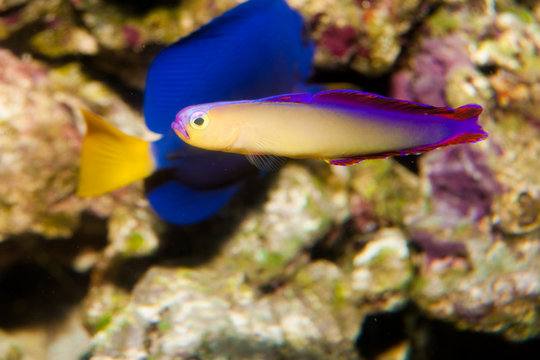ANIMAL: Purple/Elegant Firefish Nemateleotris decora Type of Animal: Goby Habitat: Hard open reef bottoms, sandy patches, rubble, rubble patches at reef bases, deeper coastal outer reef drop-offs w/ strong currents, rocky areas, found at depths of 82-230 ft Location(s): Indo-Pacific Appearance: Slender colorful fish w/ purple head area, whitish to yellowish body, darkening to very deep gray towards tail, longitudinal bands of purple/red/black/orange on fins, yellowish area around eyes Food/Diet: Zooplankton, planktonic crustaceans, planktonic crustacean larvae, copepods, krill, shrimp, squid, clams, mussels Status in Wild: Stable Conservation: Breeding in aquariums, aquaculture, & zoos Lifestyle: Male-female pairs-sometimes in close proximity to other pairs Additional Info: Called: Male Female Young: Fry Group: Colony Weight: 0.008 oz, same for both sexes Gestation: 8-10 days Life Span: 3-5 years Body Length: Male: 3.543-3.937 in Female: 2.362-3.543 in Young: 0.4 in Also called Decorated Firefish, Purple Dartfish, Decorated Dartfish, Flame Firefish, Flame Fire Goby, Elegant Fire Goby, Purple Fire Goby, Decorated Fire Goby, Firefish Goby, & Purple Wormfish. Pairs are territorial over their small patches. Pairs build nests & guard eggs until they hatch. Sometimes, they’ll even guard planktonic fry. Eggs hatch as planktonic larvae. These small fish have lots of energy. When alarmed, they’ll dart into holes/small crevices. Each spawning results in 400-500 eggs w/ pairs spawning up to 4 times a month. Juvenile stage reached at 5 weeks old. Maturity reached at 10 months old. These fish spawn all year round. Eggs whitish & 2 mm in diameter. Use elongated dorsal fin to communicate w/ other firefish. Fun Fact(s): These fish are very shy in the wild & like to hide. While shy, they’re also fairly inquisitive. One of the most popular firefish/dartfish in captivity. These fish are fairly easy to care for. These fish rather difficult to breed in captivity. 1st discovered by Western science in 1973 by ichthyologists Jack Randall (died April 26, 2020) & Gerry Allen (still alive-born March 26, 1942). Soon after, they made way into aquarium trade. Nowadays, these fish fairly common in aquarium trade. These fish are great jumpers & need to kept in tightly-sealed tanks if kept in aquariums. They’ll jump out of water if threatened.
